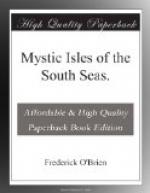Afa, the tane of the lovely Evoa of the Annexe, brought to the luncheon Annabelle Lee, the buxom wife of Lovaina’s negro chauffeur. She was a quadroon, a belle of dark Kentucky, with more than a touch of the tar-brush in her skin and hair, and her gaudy clothes and friendly manner had won the Tahitians completely. She was receiving much attention wherever she went in Tahiti, for she had the fashion and language and manners of the whites, as they knew them, and yet was plainly of the colored races. The chauffeur himself, a self-respecting negro, had sat at table with Lovaina many times. There was in Tahiti no color-line. In America a man with a drop of colored blood in his veins is classed as a colored man; in Cuba a drop of white blood makes him a white man. The whites honor their own pigment in all South America, but in the United States count the negro blood as more important. In Tahiti all were color-blind.
The amuraa maa was over in a few hours. There were no speeches, but much laughter, and much singing of the himene written by the king, “E maururu a vau!”
The tune was an old English hymn, but those were all the words of the song, and they meant, “I am so happy!” They were verses worthy of monarchy anywhere, and equaled the favorite of great political gatherings in America, “We’re here because we’re here!”
“When I was made chief of Mataiea,” said Tetuanui, reminiscently to me as we sang, “I went, as was the custom, to Papeete to drink with the king. He had just fallen down a stairway while drunk, and injured himself severely, so that our official drinking was limited. He hated stairs, anyhow, but his trouble was that he mixed his drinks. That is suicidal. He would empty into a very large punch-bowl champagne, beer, absinthe, claret, whisky and any other boissons, and drink the compound from a goblet. He could hold gallons. He was dead in two weeks after I had my chiefly toasts with him. His body was like an old calabash in which you have kept liquor for a quarter of a century. We had no alcohol until the whites brought it.” Tetuanui ended with a line of Brault’s song about Pomare: “Puisqu’il est mort ... N’en parlons plus!”
Mataiea was the farthest point on Tahiti from Papeete I had reached, and wishing to see more of the island, I set out on foot with Tatini, my handmaid. We bade good-bye to Tetuanui and Haamoura and all the family after the dawn breakfast. Mama Tetuanui cried a few moments from the pangs of separation, and the chief wrung my hand sorrowfully, though I was to be back in a few days.
From the reef at Mataiea I had glimpsed the south-west of Tahiti, the lower edge of the handle of the fan-shaped double isle, mountainous and abrupt in form, and called commonly the presqu’ile de Taiarapu. The chief said that at the isthmus of Taravao, the junction of the fan and handle, there was the Maison des Varos, a famous roadhouse, kept by M. Butscher, where one might have the best food in Tahiti if one notified the host in advance.




